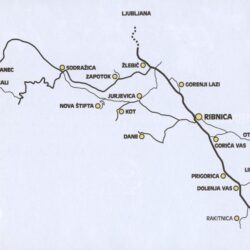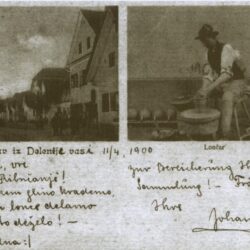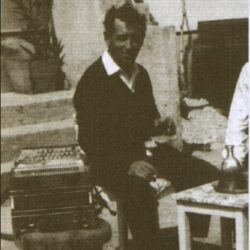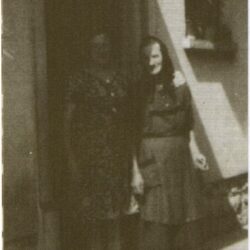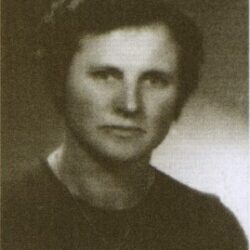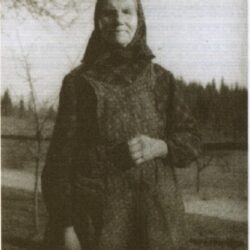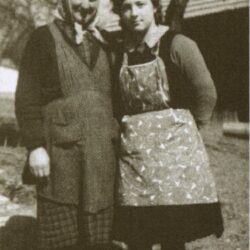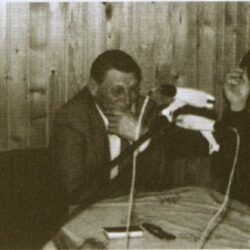From Ribnica to Rakitnica: Folk Songs and Music of the Ribnica Valley

GNI M 26.391
Recorded: Žlebič, 1964
Sung by: Angela Lovšin, vulgo Ulčarjeva (1926) from Slatnik and Mara Klun, Angela’s sister (1921)
The clever, ambitious and witty people from Ribnica are best known for the »Ribniška« song which became popular after France Marolt arranged it. The lyrics were written sometime between 1861 and 1872 by Janez Podboj, a local also known as Cénetov. However, the song Od Ribnice do Rakitnice (From Ribnica to Rakitnica) seemed more appropriate for the first track on the audio publication as it is older; it was first written down already in the 18th century. The last three stanzas were added in the 1930’s when the people unsuccessfully tried to have the town cobble stoned.
GNI M 26.240
Recorded: Goriča vas, 1963
Sung by: Ivana Nosan, vulgo Šuštarjeva Johana (1895), originally from Ribnica; Kristina Mate, vulgo Matétova Kristina (1923), originally from Slatnik; Marija Marolt, born Lavrič (1922), originally from Retije in Loški Potok
Some villages and the town of Ribnica are given teasing names in the song. The last stanza must have been modernized; it says that the girl will marry the one who »rides in a car« which replaced the older »rides in a carriage«.
GNI M 26.189
Recorded: Prigorica, 1963
Played by: Franc Kromar, vulgo Šamútkov France (1932) from Dolenja vas
Pokšotiš (Clap Šotiš) is a well-known dance in Slovenia with a slightly different name in the Dolenjska Region. It includes the characteristic clapping of hands and stamping with feet. At the time of recording, the dance had been forgotten in many areas, but the Špan family from Prigorica could still dance it.
GNI M 26.185
Recorded: Prigorica, 1963
Sung by: Neža Klun, vulgo Špánova mati (1893), originally from Goriča vas; her daughter-in-law Vida Klun (1925), originally from Dolenja vas; Vida Klun, vulgo Špánova (1926), Neža’s daughter
The song used to be sung by boys who stood under the window when the bridegroom went to propose to his sweetheart with his father or another man. The proposal was successful when the dowry was agreed.
GNI M 26.198
Recorded: Prigorica, 1963
Sung by: Karel Klun, vulgo Špánov Korl (1924); Anton Izlaty, vulgo Anžíčev Anton (1929); Franc Zobec, vulgo Andréjcov France (1928), Franc Kromar, vulgo Šamútkov France (1932) from Dolenja vas
On the farewell evening before the wedding, the local boys sang this song under the bride’s window. To thank them, the bride gave them some money, that is why it was said they so prišli po tolar (came to get the money).
GNI M 26.191
Recorded: Prigorica, 1963
Played by: Franc Kromar, vulgo Šamútkov France (1932) from Dolenja vas
Sung by: Neža Klun, vulgo Špánova mati (1893); her daughter-in-law Vida Klun (1925) and Karel Klun, vulgo Špánov Korl (1924).
Before the wedding ended, the wedding guests formed a long queue and coiled around the farmyard and garden. During the coiling, the wedding guests imitated everything the first person in the queue did. This was called gredo Abrahama (to do Abraham) after the song’s first words.
GNI M 47.256
Recorded: Žlebič, 1997
Sung by: Vida Klun, vulgo Špánova (1926) from Prigorica; Marija Klun, vulgo Andréjcova (1933) from Prigorica; Karel Klun, vulgo Špánov Korl (1924) from Prigorica; Nežka Izlaty, vulgo Anžíčeva (1929) from Prigorica; Anton Izlaty, vulgo as Anžíčev Anton (1929) from Prigorica
During the wedding feast, various songs could be heard, especially the drinking ones. Le pijmo ga, ne glejmo ga (Let’s drink it, not look at it) is one of such less known songs and is in fact composed of two different songs, usually sung separately.
GNI M 26.903
Recorded: Sodražica, 1964
Sung by: Tone Lovrenčič (1908)
This drinking song was more common. It is about the passage in the gospel about the first miracle when Jesus turned water into wine in Cana of Galilee.
GNI M 47.250
Recorded: Žlebič, 1997
Sung by: Vida Klun, vulgo Špánova (1926) from Prigorica; Marija Klun, vulgo Andréjcova (1933) from Prigorica; Karel Klun, vulgo Špánov Korl (1924) from Prigorica; Nežka Izlaty, vulgo Anžíčeva (1929) from Prigorica; Anton Izlaty, vulgo as Anžíčev Anton (1929) from Prigorica
There was a time for the more witty songs at wedding parties as well. One of them is about Adam, regretting his plea to God for Eve. The song is known all over Slovenia.
GNI M 27.077
Recorded: Kračali (Gora nad Sodražico), 1965
Played by: Janez Čampa, vulgo Bótrni stric (1892)
In Gora nad Sodražico, the dance in which the couple clapped hands and stamped their feet, then danced a polka, was not called pokšotiš as elsewhere but čotiš. The dance had the same name in the Notranjska and in the Gorenjska Regions.
GNI M 26.349
Recorded: Lipovec, 1964
Sung by: Marija Henigman, vulgo Lízna mati (1889), originally from Kot
The deceased used to lie at home until the funeral. Their family, neighbours and friends held a wake for them. They preyed and sang. The singer of Le padej, padej droben dež (Keep falling, keep falling, light rain) said she was sure the song is very old and indigenous to the area as she had heard it from her mother when she was a child. The song is unknown in other parts of Slovenia.
GNI M 26.940
Recorded: Podklanec, 1964
Sung by: Franca Košmrlj, vulgo s Ta-Dúlejna Matéča (1905), originally from Vrhnika pri Ložu, and Pepa Mihelič, vulgo Véncleva (1915)
This is another waking song which is known practically all over Slovenia.
GNI M 26.225
Recorded: Otavice, 1963
Sung by: Štefka Knavs, vulgo Knavsava (1933)
As the previous song, this one too is well-spread. The narrative song is about a widower and his child who stand at his wife’s grave. In the Ribnica Valley, six variants of the song were recorded, all with a different melody. Only one variant starts with the same words as the one on the audio publication, other variants begin in Lansko leto sem se oženu (I got married last year).
GNI M 47.238
Recorded: Nova Štifta, 1997
Bell chiming by: Jože Šega, vulgo Ogradarjev (1931) and Tadeja Šilc (1980)
Sometimes, pritrkavanje (bell chiming) can also be heard in the event of death in some places. In the Ribnica Valley it is only heard on religious holidays in order to make the occasion more solemn. Typical of Slovenia, bell chiming is the striking of bells with the clapper, only the biggest bell can be pulled by the rope. The former is called pritrkavanje na stoječe (the standing bell chiming) and the latter na leteče (the flying bell chiming).
GNI M 26.932
Recorded: Sodražica, 1964
Narrated by: Milka Cuderman, vulgo Tekávčeva Milka (1907)
Zlati očenaš (The golden Lord’s prayer) belongs to religious songs. It is a Slovenian folk passion about the suffering of Jesus Christ. The verses are spoken, just like in a prayer. It is usually very long, the one we included on the audio publication is a shorter example from Sodražica.
GNI M 26.406
Recorded: Ribnica, 1964
Sung by: Ana Klun, vulgo Krámarjeva (1924); Ivana Mrak, vulgo Sínovška Ivana (1909), Pavla Kos vulgo Bártolova Pavla (1901); Andrejc Petelin, vulgo Šúščev (1930) from Gasa
The religious song called Žalostna mati pod križem stoji (The sad mother stands under the cross) is special. It might be the forerunner of the rosaries because, although in a slightly different way, it explains the »secrets« of the sad rosary. The melody is very old as well, sung in three-part five-eight rhythm (quarter note, eighth note, quarter note).
GNI M 27.040
Recorded: Sodražica, 1964
Narrated by: Ivana Levstek, vulgo Opáldarjeva (1910), originally from Hrovača
The recording is an example of folk evening prayers. They were said by children and adults alike. Their content is less elaborate than the Lord’s prayers but they were popular with people just as well.
GNI M 26.337
Recorded: Lipovec, 1964
Narrated by: Janez Gorše, vulgo Méžnarjev Janez (1949) from Rakitnica
On New Year’s people wish each other happiness. Carols are sung but some spoken good wishes have also been preserved. Before 1819, Jožef Rudež recorded the lyrics of the New Year carol and noted that »it is heard at the so-called carol-singing«. He did not record the melody but it can be seen that the carol is very old by the verse type. Unfortunately, the New Year carols are no longer sung in the villages of Ribnica, but the spoken good wishes are still remembered. Boys used to go from house to house on New Year’s morning, wishing people good luck.
GNI M 47.277
Recorded: Zapotok, 1997
Sung by: Frančiška Čampa (1913); Marija Lovšin (1913); Anton Tanko, vulgo s Šímanov (1928); Ivan Košir, vulgo Koširjev (1939); Alojz Arko, vulgo Ta-Zlájni (1928)
The same Epiphany carol is still sung in the whole valley. The lyrics are believed to be indigenous to the area.
GNI M 27.058
Recorded: Podklanec, 1965
Played by: Janez Perušek, vulgo Brlógar (1907), moved from Novi Kot na Blokah
Ajncpolka (One-step polka) is similar to the widely-spread dance called ceprle which is known for the shaking of the whole body. The Ribnica form of ajncpolka is special: after every six measures of the springing polka, four ordinary steps without the spinning are inserted. The musician on the recording adds two humourous lines sung while playing.
GNI M 26.988
Recorded: Sodražica, 1964
Narrated by: Zinka Benulič, born Petek, vulgo Trščeva Zinka (1929)
In the old days when people could not afford to send for a doctor, they used home medicine or incantations. They originated from the pagan times and were Christianized where God or saints are mentioned. People dealt with smaller problems themselves but they always asked some older people who could say incantations for help with the bigger ones. Boháva mama from Jurjevica could say one such incantation to cure the eyes.
GNI M 26.351
Recorded: Lipovec, 1964
Sung by: Marija Henigman, vulgo Lízna mati (1889), originally from Kot
When people suffered from draught or excessive rain in Lopovec, they prayed in the chapel. In the evening after the prayer, they sang to the Father to give them much needed rain or sunshine.
GNI M 26.393
Recorded: Žlebič, 1964
Narrated by: Angela Lovšin, vulgo Ulčarjeva (1926) from Slatnik
During thunderstorms, Ulčarjeva mati from Slatnik went to every window in the house, trying to protect it against the storm. The phrase šmarni oblak (St Mary’s cloud) indicates how much people used to trust Mary to help them in the summer heat when thunderstorms were common. According to folk tradition, the period between the Assumption (15 August) and Mary’s Nativity (8 September) was dedicated especially to Mary.
GNI M 27.002 – 27.005
Recorded: Sodražica, 1964
Sung by: Zinka Benulič, born Petek, vulgo Trščeva Zinka (1929)
As in other places in Slovenia, people in Ribnica, too sang special verses as to imitate the bell-ringing. The recordings on the audio publication are from churches around Sodražica.
GNI M 27.080
Recorded: Kračali (Gora nad Sodražico), 1965
Played by: Janez Čampa, vulgo Bótrni stric (1892)
Navadna polka (Ordinary polka) was probably named so because a polka with three ordinary steps was danced to this tune. There was no jump, which differentiates this polka from the springing ajncpolka.
GNI M 27.147/b
Recorded: Dane, 1966
Sung by: Marija Tekavec, vulgo Skájževa (1896)
The Ribnica Valley is renowned for the number of narrative songs, some of which are extremely rare. Naturally, it is impossible to present all of them but at least a part of the song called Lepa Vida (The beautiful Vida) had to be included. Skájževa mati from Dane was taught the song by her aunt, Hríbarska from Mali Zapotók, who learned it from her mother. Taking into consideration that an unknown person recorded the song’s lyrics for Korytko when he was staying with Rudež, it can be assumed that the song was spread in other parts of the Ribnica Valley, too. France Prešeren must have based his Lepa Vida poem on the song’s version from the area. The song’s roots go back to medieval times, whereas the song’s contents was borrowed from the European ballad about the trick abduction of a young mother by a pirate.
GNI M 27.109
Recorded: Gorenji Lazi, 1965
Sung by: Angela Košmerlj, vulgo Gorníkova (1909), originally from Dolenji Lazi and daughter Marija (1947)
According to the lyrics and verse type (the two-part trochee octosyllable), this is a medieval song. It is about the revenge of an abandoned lover. In its oldest version (from the end of the 15th century), she gives her unfaithful lover a potion which makes him fall ill with an incurable disease. The recording on the audio publication is a different version in which a boy leaves his sweetheart because she is poor. The sweetheart then sprinkles holy water over him, and he dies. There also exists the third version where the boy dies when his sweetheart does not want to give him medicine, punishing him for his marriage with a foreigner in Tyrol.
GNI M 27.132
Recorded: Zapotok, 1965
Played by: France Šilc, vulgo Lípcov (1912) from Gorenji Lazi
Mlinček (The mill) is a three-beat dance which got its name after the song accompanying it, called Ob bistrem potoku je mlin (There is a mill next to a clear stream). The couple first swung and slapped their hands, then waltz-danced. Because of the clapping of the hands, the dance was also called pokšotiš (clap šotiš).
GNI M 27.118/b
Recorded: Dane, 1966
Sung by: Marija Tekavec, vulgo Skájževa (1896)
The medieval castle song is about a count who kills his unfaithful wife for having given birth to another man’s child in the seven and a half years he was away. Until the melody was recorded in 1965, only the song’s lyrics were known from Rudež’s records.
GNI M 26.119
Recorded: Goriča vas, 1963
Sung by: Pepca Strle, vulgo Gregúrjeva Pepca (1919) from Gradež pri Turjaku
The short, old medieval narrative song is about a boy, deadly wounded in a fight, who took to his sweetheart. Whereas the tidrajlalom refrain in every third verse of each stanza might seem unusual for such a sad song it must be noted that in folk songs, the function of refrains was only the form.
GNI M 26.190
Recorded: Prigorica, 1963
Played by: Franc Kromar, vulgo Šamútkov France (1932)
Zibenšrit (Seven-step dance) is a dance of foreign origin. It has a typical seven-step form which gave it its name. It is spread all over Slovenia, known under a different name in some places. The musician learned it from his father.
GNI M 27.107
Recorded: Gorenji Lazi, 1965
Sung by: Angela Košmerlj, vulgo Gorníkova (1909), originally from Dolenji Lazi and daughter Marija (1947)
When the song about Urška, a girl who was sentenced to death for infanticide and executed in Ljubljana on 22 October 1766, spread all over Slovenia it came to the Ribnica Valley as well. Its lyrics were recorded in 1876 and a hundred years later, an audio recording of it was made.
GNI M 27.146/b
Recorded: Dane, 1966
Sung by: Marija Tekavec, vulgo Skájževa (1896)
This is a well-known song about an orphan and her mean step-mother. What makes it so interesting is the fact that the orphan in the song is St. Christine who was martyred under Diocletian’s rule, even though no known legend tells about a stepmother of hers. The song is medieval which is clearly seen in the verse form (the 5+5 lyric decasyllable) and its simple melody.
GNI M 27.132
Recorded: Jurjevica, 1963
Sung by: Terezija Petek, also known as Trščeva Rezka (1910), originally from Globel pri Sodražici
The song about a beggar and a lady of a castle who denied him shelter for the night and was thus doomed was recorded in Globel pri Sodražici by Janko Žirovnik in 1908. Half a century later, an audio recording of the same song was made.
GNI M 26.193
Recorded: Prigorica, 1963
Played by: Franc Kromar, also known as Šamútkov France (1932)
Povštertanc (Pillow dance) is a dance game where the dance partner is chosen with a pillow. Dancers form a circle and turn left or right, the dancer who is choosing his partner is in the centre. When he finds a dancer he wants, he throws the pillow in front of her. They kneel on the pillow, kiss and dance. After that, the chosen dancer repeats the game.
GNI M 27.127
Recorded: Zapotok, 1965
Sung by: Franc Gorše, vulgo Francétov (1909); Janez Košir, vulgo Košírjev (1914); Lojz Čampa, vulgo Matíčev (1903); Janez Gorše, vulgo Jánazov (1911); Jože Čampa, vulgo Lúžarjev (1908); Alojz Gorše, vulgo Šímanov (1910); Franc Šilc, vulgo Lípcov (1912)
Love is an elementary human feeling. It is then no wonder why the Slovenians, a nation with a long singing tradition, have so many love songs. Some were sung by boys as they went wooing in the evening. The singing was polyphonic (multipart singing), different from all choir singing. The song on the audio publication is an example of such singing.
GNI M 47.272
Recorded: Zapotok, 1997
Sung by: Anton Tanko, vulgo s Šímanov (1928); Ivan Košir, vulgo Košírjev (1939), Alojz Arko, vulgo Ta-Zlájni (1928)
Thirty years later, three people from the same village sang a love song. It was still multipart singing but some choir singing elements can already be heard.
GNI M 26.192
Recorded: Prigorica, 1963
Played by: Franc Kromar, vulgo Šamútkov France (1932)
Šuštarska (Shoemakers’ song) used to be the song of the shoemakers’ guild. When it became a social dance, it spread to Slovenia as well. The couple kneels and imitates the sewing with shoemakers’ thread and the pounding of wooden nails.
GNI M 47.271
Recorded: Zapotok, 1997
Sung by: Anton Tanko, vulgo Šímanov (1928); Ivan Košir, vulgo Košírjev (1939), Alojz Arko, vulgo Ta-Zlájni (1928)
The last song on the audio publication is also a love song but it does not seem very old. This is the beauty of folk tradition where the old and the new coexist, although very different in form and contents.
GNI M 27.081
Recorded: Kračali, 1965
Played by: France Čampa (1930), the son of Bótrn stric
Polka has been one of the most popular dances in the Ribnica Valley, since World War I. Couples turn left or right on the spot or along the circle in three-steps (two eighth notes, one quarter note) or ordinary steps.
Zmaga Kumer: From Ribnica to Rakitnica – Folk Songs and Music of the Ribnica Valley
The Ribnica Valley is a vast karst plain about 12 km long and only 5 km wide. It is surrounded by plateaus; in the southwest rises Vélika gora (the Big Mountain, 1254 m) which is covered with coniferous trees, a prime source of the timber industry in the valley. Along it stretches Brezje, a narrow mountain ridge rich with clay which provided the local potters with plenty of material. Across the Vélika gora which is interspersed with a system of streams lies Mala gora (the Little Mountain, 876 m) which is covered with deciduous trees and very dry; its sinkholes are typical example the karst region. In the south, the valley is closed by the low Jasnica plateau.
Ribnica is one of the oldest settlements in Slovenia. It was first mentioned in 1082. Ribnica was plundered and set on fire several times by Turks. Due to its central position in the valley, Ribnica’s only point of defence was the mighty castle on the right bank of the Bistrica underground stream. Ownership of the castle changed hands many times until Anton Rudež, the castle keeper, bought it from the then lord. Before World War II, the castle was sold again, and was badly damaged in 1944. After the war, parts of the castle were restored and they now house a museum which is a part of the Ribnica Cultural Centre. The Centre is located in the Miklova hiša House and it also bears its name.
Already in medieval times, Ribnica had a parish church, and in the beginning of the 15th century it had a Latin school which is believed to be the first of the kind in Carniola. In the 19th century, the school was widely known.
Sodražica, another bigger settlement in the valley, lies on edge of Vélika gora and Slémena. It has long been an important trade and crafts centre. In Roman times, the road to Postojna led through Sodražica.
The valley is fertile but there are not a lot of fields. The villages are quite big, some scattered, others built along the main road. In the past few decades, many fields had to give way to houses or industrial buildings. Farms have always been very small, that is why the locals in the upper villages produced wooden ware and people in the lower villages took on pottery which made them quite famous. Since farming became impossible due to Turkish invasions, emperor Fridrich III gave them permission to earn their living by peddling in 1492.
The first person who recorded folk songs in the Ribnica Valley was Jožef Rudež (1793–1846), the son of Anton Rudež (1757–1829) who was Valentin Vodnik’s classmate and Žiga Zois’ friend. It must have been his father’s interest in the Slavic studies which made Jožef so enthusiastic about “all folk things”, including songs. It was him who enabled Emil Korytko to come to Ribnica, and his son, Anton Jr. was a good acquaintance of Stanko Vraz. It was this friendship that later caused Karel Štrekelj, who was gathering material for the collection of Slovenian folk songs for the Slovenska matica publishing house, to come across Vraz’s legacy among which were the 24 records of Anton Rudež. Rudež wrote down the songs between 1811 and 1819, which makes them one of the oldest folk song records in Slovenia.
Another important collection of songs is the work of Anton Zobec from the village of Hrovača. As a secondary school student in the 1870’s, he collected 22 songs.
In 1908, Janko Žirovnik recorded 47 songs in Ribnica and the surrounding villages. A few songs were also recorded by the organist Andrej Fajdiga from Sodražica and Matevž Ravnikar – Poženčan who was a priest in the village of Gora nad Sodražico.
The Institute of Ethnomusicology conducted systematic gathering of material between 1963 and 1966 which resulted in 612 audio recordings. They were published in a book called “Ljudska glasba med rešetarji in lončarji v Ribniški dolini” (Folk music of potters and sieve makers in the Ribnica Valley), Maribor, Obzorja 1968, 462 pages. In 1997, the Institute’s researcher Igor Cvetko recorded the additional 23 examples of bell chiming and 37 songs and tunes. Altogether, the Institute is currently holding as many as 837 audio or written recordings of folk songs and tunes from the relatively small geographical area.
This invaluable collection is partly represented on this audio publication. We tried to include the most typical recordings but the quality of the recordings was also a criterion. On the audio publication, the recordings are sorted according to the contents: the audio publication starts with song of local character, you can then hear wedding, drinking and humorous songs, then wake and religious songs, in the next group are examples of a folk evening prayer, New Year’s wish, Epiphany carol, incantation and a weather prayer, followed by narrative songs (ballads) and love songs. In order to present the heritage of folk musicians, and to for greater variety, the tunes of typical folk dances in the Ribnica Valley and an example of bell chiming are included as well.
Unlike author music which is very formalized, folk songs live with people. That is why they can exist unchanged for centuries alongside the new ones, or can be modernised in contents, form or the way people sing it. The recordings on the audio publication show that the same is true for the folk song tradition in the Ribnica Valley.
Forty years ago, when I was gathering material and did not leave a stone unturned in the Ribnica Valley, I too, born in Ribnica, felt that homeland is a lot more than just a word and that I am deeply rooted in it. A comprehensive presentation of my recordings was published in a book which I wrote with all my heart and sense of responsibility. Now that a part of the recordings appear on the audio publication and in such a way celebrate the singers and musicians of the old days, I wish that the present-day people of Ribnica realized how beautiful and valuable their musical heritage is.
Ljubljana, August 2003 Zmaga Kumer
